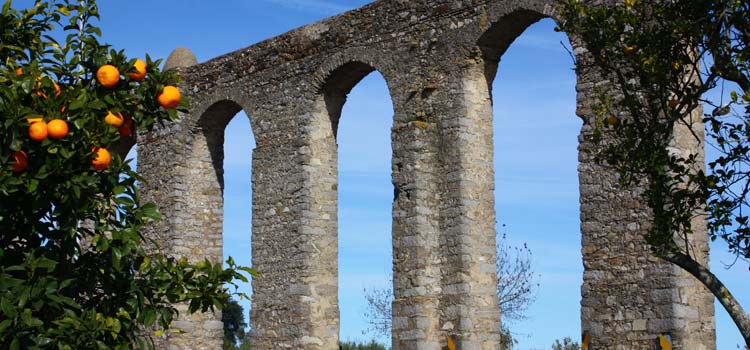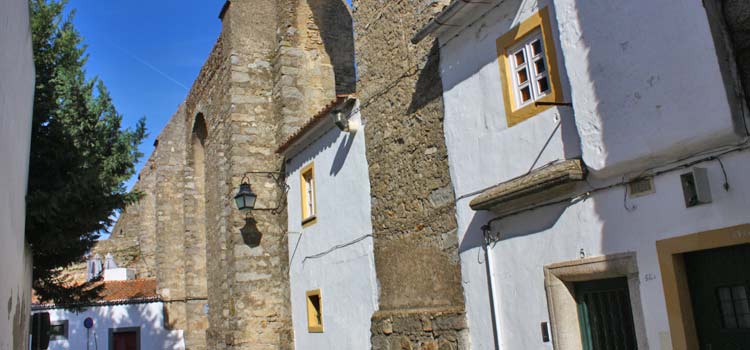MyPortugalHoliday.com
The best independent guide to Central Portugal
MyPortugalHoliday.com
The best independent guide to Central Portugal
Aqueduto da Água de Prata: Evora Aqueduct
Evora contains one of the Iberian Peninsula's greatest 16th-century building projects, the Aqueduto da Água de Prata (the Evora aqueduct). The aqueduct provided clean drinking water to Evora by connecting the city to the nearest year-round spring of freshwater 18km to the northwest.
The channelled water flowed through a complex set of structures that included long tunnels, deep valleys and, most impressively, over massive stone aqueducts. This clever design meant that the water from the river could flow unassisted into the Praça do Giraldo, the main plaza of Evora.
Related articles: Introduction to Evora
The Evora Aqueduct for visitors
There are two main aspects of the Evora Aqueduct for you to see:
• The section inside the city walls and along the Rua do Cano.
• The colossal stone arches to the north of Evora.
Under these arches, charming little houses and shops have been constructed, and now the aqueduct appears as almost a secondary wall to the city. The best streets to view the aqueduct are around the Rua do Cano, Rua do Salvador and Travessa das Nunes.

The massive stone Evora aqueduct outside of the city walls by the ring road
Outside Evora, the arches are mighty and have weathered the turbulent history of the region. There are two good locations to view the aqueduct: the first is just outside the city walls, by the ring road. Here the arches are the highest, reaching 25m high. The second location is where the aqueduct crosses the R114, 1 km north of Evora.
The History of the Água de Prata Aqueduct Evora
The Alentejo region has very hot summers and mild dry winters, with minimal rain throughout the year. The scant supply of groundwater extracted via wells limited Evora's early growth, and there was the constant fear of drought.
This changed under the reign of King John III (Joao III 1502 –1557), who decreed that Evora should have a constant supply of fresh water. This was only possible by the construction of the Aqueduto da Água de Prata. 20km to the north of Evora is lake Barragem do Divor, and from this lake a small river, the Ribeira do Divor, flows. The river passes within 9km of Evora, and Evora aqueduct connects the Ribeira do Divor to Evora.
King Joao III selected a military architect, Francisco de Arruda, to design the water system. Francisco de Arruda most famous construction project was the Torre de Belém in Lisbon, which stands in the centre of the Rio Tejo. The aqueduct was started in 1531 and took 6 years to construct, with the majority of the time spent building the final few kilometers of the aqueduct.

The arches of the aqueduct as they enter Evora
The northern sections of the Evora aqueduct, close to the river Ribeira do Divor, pass through tunnels and channels, but closer to Evora aqueducts had to be built to span the wide valleys. These grand stone arches of the Aqueduto da Agua de Prata were the major engineering achievement, and they impress most visitors to Evora. The highest of the Evora aqueduct arches is 26 meters high and spans one of the main roads into the city.
As the Aqueduto da Água de Prata passes into Evora from the north, the town has evolved around the grand arches, with shops, houses and businesses being constructed underneath. The most intriguing constructions are located around the northern street of Rua do Cano. The original design had the main water outlet in the Praça do Giraldo, the main central square of Evora.
During the Spanish and Portuguese War of Restoration (1640 –1668), Evora found itself at the centre of the fighting, and the Aqueduto da Água de Prata was an ideal target for destruction by raiding armies from both sides. The Aqueduto da Água de Prata was repaired during the 17th century, but one of the major alterations was that the main outlet was removed from Praça do Giraldo.
The silver (Prata) in the name of the aqueduct has a double meaning: the silver could imply the crystal clear waters from the Divor River that flowed into Evora, or the huge amount of silver that had to be paid for the costly project.


























